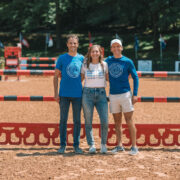Dressage Movements Explained: The Difference Between Travers, Renvers, and Shoulder-In
When your coach is calling out dressage movements for you to do, it can be difficult to keep them all straight. Travers, renvers, shoulder in, next thing you know your head is spinning. While learning the ins and outs of every move takes time and a good coach, we’re here to help you understand the basics of the different dressage movements.
Shoulder-In – Shoulder-in is the big kid version of shoulder-fore. During the shoulder-in movement, the horse’s inside hind leg will follow the track of the outside front leg. Their shoulders will be shifted toward the inside away from the rail.
During this movement while the shoulder is shifted in, the hind legs will stay on the rail. One of the easiest ways to teach a horse shoulder-in is with a 10-meter circle. The feeling of initially going into that circle is similar to starting your shoulder-in movement. Riders can expect to see shoulder-in at second level dressage after learning shoulder-fore during first level.
Travers – Did she say travers or renvers…and do you even remember which is which? In its most basic form, travers is the head to the wall movement with the haunches out. The horse will be bent around the rider’s inside leg and will step forwards and sideways.
This movement is best taught to horses at the walk, and is typically performed at a collected trot or canter. Got it? No? Ok. Travers: forehand on the track, the hindquarters leave the track at the beginning of the movement and do not return until the movement is finished. Travers is a second level dressage movement that riders can expect to encounter.
Clear as mud? Here’s a picture to help you understand how to ride the movement.
Renvers – Renvers is almost identical to travers if you were riding in an open field. The difference between the two is a matter of which way you move the horse’s body based on where they’re at in the dressage ring. Example: Renvers tracking to the left is the same positioning of the horse’s body as travers tracking to the right.
This is where you compare the two pictures because otherwise that sentence is difficult to visualize in your mind. While travers is head to the wall with the haunches out, renvers is haunches in towards the wall and then the shoulders shift out. Renvers is a third level dressage movement.
All three movements are different parts of the process of changing your horse’s balance and rideability. There are many online resources for learning how to ride each movement, but a dressage trainer is the best way to make sure you and your horse are learning the right foundation in your dressage training.





